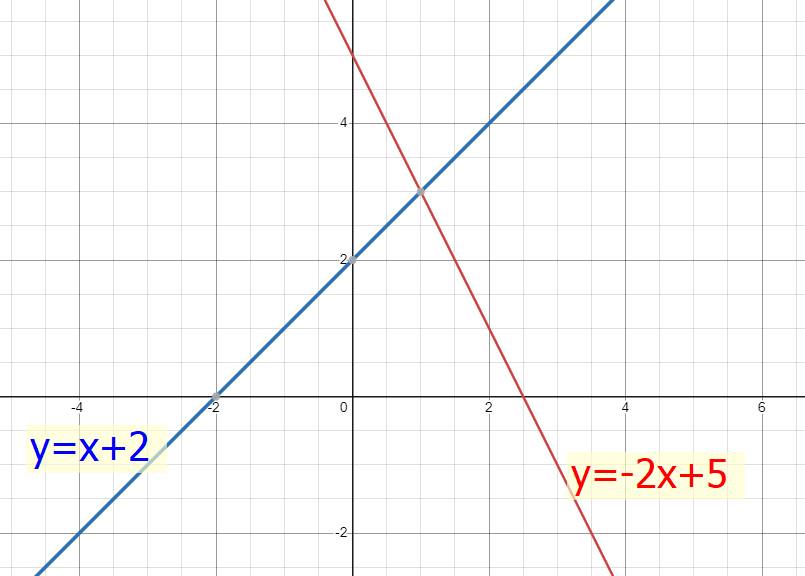 phương trình bậc nhất 1 ẩn ạ
phương trình bậc nhất 1 ẩn ạ
Hãy nhập câu hỏi của bạn vào đây, nếu là tài khoản VIP, bạn sẽ được ưu tiên trả lời.


a) Bảng giá trị
 Đồ thị:
Đồ thị:

b) Phương trình hoành độ giao điểm của (d₁) và (d₂):
-x + 5 = x + 2
-x - x = 2 - 5
-2x = -3
x = 3/2
Thay x = 3/2 vào (d₂), ta có:
y = 3/2 + 2 = 7/2
Vậy tọa độ giao điểm M(3/2; 7/2)
c) Gọi (d₃): y = ax + b (a ≠ 0) là đồ thị của hàm số cần tìm
Do (d₃) // (d₁) nên a = -1
⇒ (d₃): y = -x + b
Do (d₃) đi qua K(-4; 2) nên thay tọa độ của K(-4; 2) vào (d₃), ta có:
-(-4) + b = 2
b = 2 - 4
b = -2
Vậy hàm số cần tìm là:
y = -x - 2
a) Đồ thị hs:`y=-2x+5` cắt `Ox(5/2;0)` và cắt `Oy(0;5)`
Đồ thị hs: `y=x+2` cắt `Ox(-2;0)` và cắt `Oy(0;2)`

b) Ta có pt hoành độ giao điểm của (d1) và (d2):
\(-2x+5=x+2\)
\(\Leftrightarrow x+2x=5-2\)
\(\Leftrightarrow3x=3\)
\(\Leftrightarrow x=1\)
Thay `x=1` vào `(d_2)` ta có: \(y=1+2=3\)
`=>M(1;3)`
c) Hàm số `y=ax+b` có đồ thị song song với `(d_1):y=-2x+5`
`=>a=-2`
`=>y=-2x+b`
Mà hàm số này đi qua điểm `K(-4;2)` ta thay `x=-4` và `y=2` vào ta có:
`2=-2*(-4)+b`
`<=>2=8+b`
`<=>b=2-8=-6`
Vậy hàm số đó là: `y=-2x-6`

ĐKXĐ: x ≠ 1; x ≠ -1
4/(x - 1) - A = 8/(x² - 1)
⇒ A = 4/(x - 1) - 8/(x² - 1)
= 4(x + 1)/(x² - 1) - 8/(x² - 1)
= (4x + 4 - 8)/(x² - 1)
= (4x - 4)/(x² - 1)
= 4(x - 1)/[(x - 1)(x + 1)]
= 4/(x + 1)

a: Xét ΔAFB và ΔCFI có
\(\widehat{FAB}=\widehat{FCI}\)(hai góc so le trong, AB//CI)
\(\widehat{AFB}=\widehat{CFI}\)(hai góc đối đỉnh)
Do đó: ΔAFB~ΔCFI
b: Xét ΔEAB và ΔEKD có
\(\widehat{EAB}=\widehat{EKD}\)(hai góc so le trong, AB//KD)
\(\widehat{AEB}=\widehat{KED}\)(hai góc đối đỉnh)
Do đó: ΔEAB~ΔEKD
=>\(\dfrac{AB}{KD}=\dfrac{AE}{KE}\)
=>\(AB\cdot KE=AE\cdot KD\)

\(6x^2+4xy-y^2\)
\(=6\left(x^2+\dfrac{2}{3}xy-\dfrac{1}{6}y^2\right)\)
\(=6\left(x^2+2\cdot x\cdot\dfrac{1}{3}y+\dfrac{1}{9}y^2-\dfrac{5}{18}y^2\right)\)
\(=6\left[\left(x+\dfrac{1}{3}y\right)^2-\left(\dfrac{y\sqrt{5}}{3\sqrt{2}}\right)^2\right]\)
\(=6\left(x+\dfrac{1}{3}y-\dfrac{y\sqrt{10}}{6}\right)\left(x+\dfrac{1}{3}y+\dfrac{y\sqrt{10}}{6}\right)\)
b: \(8x^2+3xy-4y^2\)
\(=8\left(x^2+\dfrac{3}{8}xy-\dfrac{1}{2}y^2\right)\)
\(=8\left(x^2+2\cdot x\cdot\dfrac{3}{16}y+\dfrac{9}{256}y^2-\dfrac{137}{256}y^2\right)\)
\(=8\left[\left(x+\dfrac{3}{16}y\right)^2-\left(\dfrac{y\sqrt{137}}{16}\right)^2\right]\)
\(=8\left(x+\dfrac{3}{16}y-\dfrac{y\sqrt{137}}{16}\right)\left(x+\dfrac{3}{16}y+\dfrac{y\sqrt{137}}{16}\right)\)

1.
\(B=\left(ab+bc+ca\right)\left(\dfrac{ab+bc+ca}{abc}\right)-abc\left(\dfrac{a^2b^2+b^2c^2+c^2a^2}{a^2b^2c^2}\right)\)
\(=\dfrac{\left(ab+bc+ca\right)^2}{abc}-\dfrac{a^2b^2+b^2c^2+c^2a^2}{abc}\)
\(=\dfrac{a^2b^2+c^2c^2+c^2a^2+2abc\left(a+b+c\right)}{abc}-\dfrac{a^2b^2+b^2c^2+c^2a^2}{abc}\)
\(=\dfrac{2abc\left(a+b+c\right)}{abc}=2\left(a+b+c\right)\)
2.
\(x+y+z=xyz\Rightarrow\dfrac{x+y+z}{xyz}=1\)
\(\Rightarrow\dfrac{1}{xy}+\dfrac{1}{yz}+\dfrac{1}{zx}=1\)
Lại có:
\(\dfrac{1}{x}+\dfrac{1}{y}+\dfrac{1}{z}=3\Rightarrow\left(\dfrac{1}{x}+\dfrac{1}{y}+\dfrac{1}{z}\right)^2=9\)
\(\Rightarrow\dfrac{1}{x^2}+\dfrac{1}{y^2}+\dfrac{1}{z^2}+\dfrac{2}{xy}+\dfrac{2}{yz}+\dfrac{2}{zx}=9\)
\(\Rightarrow\dfrac{1}{x^2}+\dfrac{1}{y^2}+\dfrac{1}{z^2}+2.1=9\)
\(\Rightarrow\dfrac{1}{x^2}+\dfrac{1}{y^2}+\dfrac{1}{z^2}=7\)

\(pt:25\left(x+1\right)^4-26\left(x+1\right)^2+1=0\\ \Leftrightarrow\left[25\left(x+1\right)^4-25\left(x+1\right)^2\right]-\left[\left(x+1\right)^2-1\right]=0\\ \Leftrightarrow25\left(x+1\right)^2\left[\left(x+1\right)^2-1\right]-\left[\left(x+1\right)^2-1\right]=0\\ \Leftrightarrow\left[\left(x+1\right)^2-1\right]\left[25\left(x+1\right)^2-1\right]=0\\ \Rightarrow\left[{}\begin{matrix}\left(x+1\right)^2-1=0\\25\left(x+1\right)^2-1=0\end{matrix}\right.\\ \Leftrightarrow\left[{}\begin{matrix}\left(x+1\right)^2=1\\\left(x+1\right)^2=\dfrac{1}{25}\end{matrix}\right.\)
\(\Leftrightarrow\left[{}\begin{matrix}x+1=1\\x+1=-1\\x+1=\dfrac{1}{5}\\x+1=-\dfrac{1}{5}\end{matrix}\right.\\ \Leftrightarrow\left[{}\begin{matrix}x=0\\x=-2\\x=-\dfrac{4}{5}\\x=-\dfrac{6}{5}\end{matrix}\right.\)
Vậy tập nghiệm pt: \(S=\left\{0;-2;-\dfrac{4}{5};-\dfrac{6}{5}\right\}\)
\(25\left(x+1\right)^4-26\left(x+1\right)^2+1=0\)
=>\(25\left(x+1\right)^4-25\left(x+1\right)^2-\left(x+1\right)^2+1=0\)
=>\(25\left(x+1\right)^2\left[\left(x+1\right)^2-1\right]-\left[\left(x+1\right)^2-1\right]=0\)
=>\(\left[\left(x+1\right)^2-1\right]\left[25\left(x+1\right)^2-1\right]=0\)
=>\(\left(x+1+1\right)\left(x+1-1\right)\left(5x+5-1\right)\left(5x+5+1\right)=0\)
=>\(x\left(x+2\right)\left(5x+4\right)\left(5x+6\right)=0\)
=>\(\left[{}\begin{matrix}x=0\\x=-2\\x=-\dfrac{4}{5}\\x=-\dfrac{6}{5}\end{matrix}\right.\)

a: Xét ΔNHM có NI là phân giác
nên \(\dfrac{IM}{IH}=\dfrac{NM}{NH}\left(1\right)\)
Xét ΔNMP có NK là phân giác
nên \(\dfrac{KP}{KM}=\dfrac{NP}{NM}\left(2\right)\)
Xét ΔNHM vuông tại H và ΔNMP vuông tại M có
\(\widehat{HNM}\) chung
Do đó: ΔNHM~ΔNMP
=>\(\dfrac{NH}{NM}=\dfrac{NM}{NP}\)
=>\(\dfrac{NM}{NH}=\dfrac{NP}{NM}\left(3\right)\)
Từ (1),(2),(3) suy ra \(\dfrac{IM}{IH}=\dfrac{KP}{KM}\)
b: Xét ΔNHI vuông tại H và ΔNMK vuông tại M có
\(\widehat{HNI}=\widehat{MNK}\)(NK là phân giác của góc MNP)
Do đó: ΔNHI~ΔNMK
=>\(\widehat{NIH}=\widehat{NKM}\)
mà \(\widehat{NIH}=\widehat{MIK}\)(hai góc đối đỉnh)
nên \(\widehat{MIK}=\widehat{MIK}\)
=>ΔMIK cân tại M
c: Ta có: ΔMIK cân tại M
mà ME là đường trung tuyến
nên ME\(\perp\)IK
Xét ΔENM vuông tại E và ΔMNK vuông tại M có
\(\widehat{ENM}\) chung
Do đó: ΔENM~ΔMNK
=>\(\dfrac{NE}{NM}=\dfrac{NM}{NK}\)
=>\(NM^2=NE\cdot NK\)
Ta có: \(\dfrac{NM}{NH}=\dfrac{NP}{NM}\)
=>\(NM^2=NP\cdot NH\)
=>\(NE\cdot NK=NP\cdot NH\)
=>\(\dfrac{NE}{NP}=\dfrac{NH}{NK}\)
Xét ΔNEH và ΔNPK có
\(\dfrac{NE}{NP}=\dfrac{NH}{NK}\)
\(\widehat{ENH}\) chung
Do đó: ΔNEH~ΔNPK
=>\(\widehat{NEH}=\widehat{NPK}\)





a) \(4x^2-1=\left(2x+1\right)\left(3x-5\right)\)
\(\Leftrightarrow\left(2x\right)^2-1^2=\left(2x+1\right)\left(3x-5\right)\)
\(\Leftrightarrow\left(2x+1\right)\left(2x-1\right)-\left(2x+1\right)\left(3x-5\right)=0\)
\(\Leftrightarrow\left(2x+1\right)\left(2x-1-3x+5\right)=0\)
\(\Leftrightarrow\left(2x+1\right)\left(4-x\right)=0\)
\(\Leftrightarrow\left[{}\begin{matrix}2x=-1\\4=x\end{matrix}\right.\)
\(\Leftrightarrow\left[{}\begin{matrix}x=-\dfrac{1}{2}\\x=4\end{matrix}\right.\)
Vậy: ...
b) \(\dfrac{x-85}{15}+\dfrac{x-74}{13}+\dfrac{x-67}{11}+\dfrac{x-64}{9}=10\)
\(\Leftrightarrow\dfrac{x-85}{15}+\dfrac{x-74}{13}+\dfrac{x-67}{11}+\dfrac{x-64}{9}-10=0\)
\(\Leftrightarrow\left(\dfrac{x-85}{15}-1\right)+\left(\dfrac{x-74}{13}-2\right)+\left(\dfrac{x-67}{11}-3\right)+\left(\dfrac{x-64}{9}-4\right)=0\)
\(\Leftrightarrow\dfrac{x-100}{15}+\dfrac{x-100}{13}+\dfrac{x-100}{11}+\dfrac{x-100}{9}=0\)
\(\Leftrightarrow\left(x-100\right)\left(\dfrac{1}{15}+\dfrac{1}{13}+\dfrac{1}{11}+\dfrac{1}{9}\right)=0\)
\(\Leftrightarrow x-100=0\)
\(\Leftrightarrow x=100\)
Vậy: ...